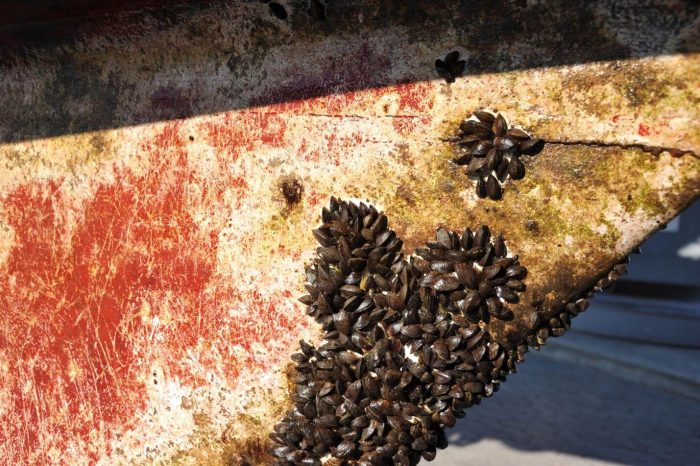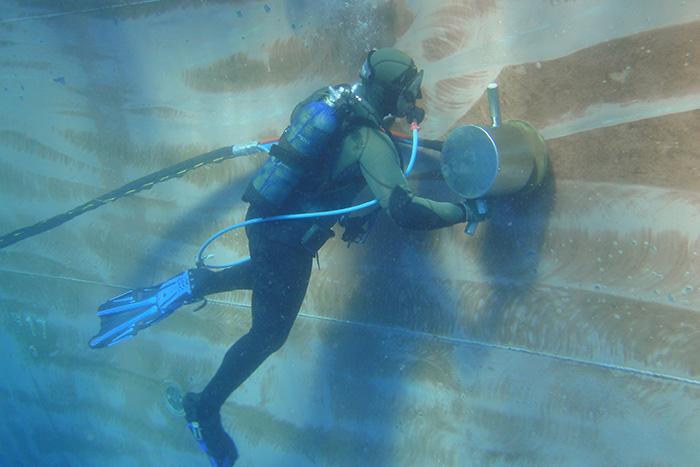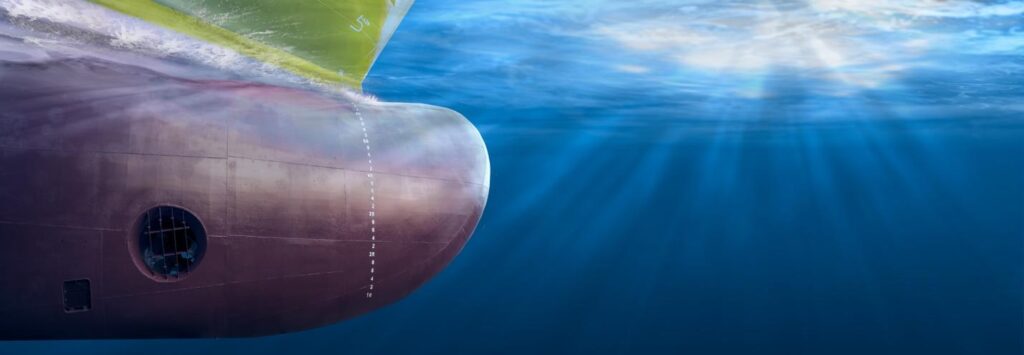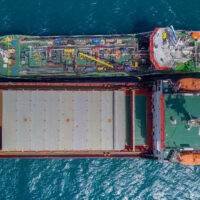Innovation in the field of ship hull coatings is helping to improve fuel efficiency, reduce air emissions, cut noise pollution, and prevent the spread of invasive species.
Every day, thousands of commercial ships transit from one part of the world to another, keeping supply chains and essential goods moving. With lifespans in the range of 20 to 25 years, merchant vessels spend a great amount of time in the ocean, cruising through tens of thousands of nautical miles and sailing through countless marine ecosystems.
If not treated with special coatings, small marine organisms can accumulate on a ship’s hull and increase the vessel’s resistance in water, leading to higher fuel consumption, greater air emissions and increased levels of underwater noise. Furthermore, the sections of ships below the waterline become vehicles for the transfer and spread of aquatic invasive species such as zebra mussels, barnacles, and tunicates.
Before diving into the specifics of hull coatings, their benefits, environmental impacts, technological advances and how they are regulated, let’s look at why they are needed in the first place.
What is biofouling and what effects does it have on shipping activities and the marine environment?
Have you ever noticed the buildup of algae or shellfish on the submerged parts of waterside structures such as the pillars of a pier? If so, you have witnessed biofouling. Through this process, also referred to as marine growth, marine organisms and species settle and accumulate on the many surfaces, nooks, and crannies of underwater structures. When biofouling occurs on the hulls, propellers, intakes, and other parts of ships that contact the water, marine species can ‘hitch a ride’ from their home ecosystem to a new one. They are then considered invasive species because they are disturbing the new ecosystem’s balance which can threaten the survival of native species in the area.

But the spread of invasive species is not the only adverse effect of biofouling. The buildup of marine organisms on ship hulls and submerged surfaces is known to have a significant impact on the overall performance and, therefore, environmental footprint of cargo vessels. Why? Because just as the clean aerodynamic lines of a car optimizes speed and performance on the road, a sleek hull ensures that ships can move effortlessly and efficiently through water.
When marine species attach to ships, they roughen the hulls, which creates friction and drag through the water. This resistance causes ships to use more fuel and emit more air pollutants and greenhouse gases during their voyages. It is estimated that biofouling – notably the accumulation of crustaceans like barnacles – can increase a ship’s resistance in water by 20% to 60%, slowing it down and leading to an increase of 40% in fuel consumption.1
And not only is a higher fuel consumption bad for the environment, it raises the operational cost for ship operators and, ultimately, for consumers worldwide who depend on marine shipping for access to goods and commodities. In-water friction caused by hulls and propellers fouled with marine organisms can also influence the levels of underwater noise ships emit in the marine environment, which can interfere with the frequencies marine mammals such as whales use to communicate, feed, reproduce, and avoid danger and, therefore, threatens their survival.
Can biofouling be prevented by simply scraping marine species off the surface of the ships and cleaning the hulls? Although hull cleaning is part of the solution, it is an expensive and time-consuming process that must be repeated over time. Furthermore, if done incorrectly, hull cleaning can accelerate the transfer of invasive species. So, what about a lasting solution that keeps the hull sleek and prevents marine growth in the first place? That’s when anti-fouling paints come into play.

What are anti-fouling paints and how do they prevent biofouling?
One of the main and most efficient solutions to prevent, manage and counter the environmental and economic effects of biofouling in ships has been the use of anti-fouling coatings. Anti-fouling coatings are a type of paint applied to the hull of a ship to prevent marine species and organisms – barnacles, zebra mussels, algae, and more – from attaching to the surfaces of vessels that contact water. By doing so, anti-fouling paints play an important role in preventing the transfer and spread of invasive species by ships and ensuring that commercial vessels can navigate without unnecessary resistance, improving their flow in the water, and the overall performance and sustainability of their voyages.
Are anti-fouling paints harmful to the marine environment?
Hull coatings are not new. For centuries, sailors and mariners have been trying to prevent aquatic life from growing on ships through hull linings, notably thin sheets of copper nailed to the hulls. Because of its toxicity to marine organisms, copper was the preferred solution against biofouling since the early days of marine transportation. But because it accelerates corrosion, copper was no longer a viable solution when iron replaced wood as the predominant material used for ship building. That is when paints (hull coatings) emerged as the anti-fouling solution par excellence.
Although effective at preventing bioaccumulation, these paints – made from compounds such as copper, arsenic, and other biocides – eventually flake off or leach out into the water releasing harmful chemicals into the marine environment. Those toxic compounds are being ingested by marine organisms, contaminating the food chain, and disrupting the growth of marine life.2 Although the use of harmful biocides such as tributyltin (TBT)3 in anti-fouling paints are prohibited since 2008, copper-based coatings, which transform the hulls into hostile environments for marine life to settle and grow, are still being used to this day.
Low friction anti-fouling paints that make it harder for marine life to attach – rather than killing it – are an alternative. Teflon-based anti-fouling paint is one of them. Just like in the kitchen, Teflon prevents anything from ‘sticking’ to the bottom of the ship and being transferred from one part of the world to another. But like other hull coatings, Teflon-based paints eventually flake-off, and result in a direct path for plastics into the ocean.
Although anti-fouling technologies have been evolving and improving over the past decades, there is still room for perfecting them to a point where the toxicity and plastic pollution that may result from coatings flake off can be eliminated. Canadian innovators think there may be a way forward.
What anti-fouling technologies are under development?
Three Canadian companies are working on anti-fouling technologies that are both safe for the marine environment and improve the efficiency of ship voyages.
A20 Advanced Materials Inc.
To prevent pollution of anti-fouling paints into the marine environment, Vancouver-based A20 Advanced Materials Inc. has developed a novel underwater adhesive that can prevent corrosion and enable durable bonding of low-friction foul-release coatings. Using proprietary self-healing technology, their non-toxic coating can extend the working lifetime of marine assets while improving vessel efficiency through reduced drag. This technology is originating from the Department of Chemistry and Chemical and Biological Engineering at the University of British Columbia. A2O is currently validating the technology through pilot demonstrations on small watercraft and fixed marine assets, such as underwater infrastructures.
Graphite Innovation & Technologies (GIT)
This Halifax-based organization has taken a different path by developing a durable low-friction coating impregnated with microscopic graphene particles that make it extremely slippery and durable. In addition to making it hard for marine organisms to attach to the slippery surface, this coating contains no biocides to leach out nor microplastics to flake off. It also has surprising sound deadening properties. Early results from full-scale trials on fishing boats in Halifax have shown that a vessel that is cleaned and freshly painted with the GIT coating glides through the water more efficiently than before it was cleaned. The company claims that the coating is even more slippery than conventional paint but hasn’t released data from the trials yet. More testing is ongoing to prove how much the GIT coating slows the bioaccumulation process.
Mirapakon
Quebec-based company Mirapakon is working on bringing to market a silicon-based coating – that is free of toxic compounds – developed by the U.S. Navy, with the primary goal of improving the efficiency of maritime activities such as shipping. This includes fuel economy provided by hulls that are free of organisms that could create in-water resistance. As part of recent trials, the technology was tested in fresh and ocean waters, including in the St. Lawrence River.
What are the rules around the use of anti-fouling paints and the prevention of biofouling?
Internationally
Recognizing that both biofouling and treatments to prevent the phenomenon can harm the marine environment, the International Maritime Organization (IMO) – the agency responsible for the safety and security of international shipping and the prevention of ship-source pollution – has established an anti-fouling convention as well as guidelines to control biofouling, while committing to further research on these topics.
In 2001, the International Convention on the Control of Harmful Anti-fouling Systems on Ships, prohibiting the use of harmful substances (metallic compounds, tributyltin and others) in anti-fouling paints, was established. In 2021, the Convention was amended to limit the use of anti-fouling paints containing cybutryne, another harmful chemical for marine life.
In 2011, the IMO published Guidelines for the control and management of ships’ biofouling to minimize the transfer of invasive aquatic species, providing ship owners and operators with recommendations to prevent bioaccumulation and reduce its associated risks, including:
- Applying anti-fouling paints on the hull and other submerged parts of the ship;
- Inspecting and cleaning of the hull, and underwater nooks and crannies;
- Developing a management plan and recording the actions taken to prevent biofouling (e.g., type of anti-fouling paints used, date of application, etc.); and
- Factoring in the type, design, and speed of the ship in the choice of anti-fouling system to use.
In 2019, microplastic pollution from hull coatings was assessed by the IMO. Further research is required to understand microplastics contributions from the cleaning and maintenance of coatings.
In Canada
The Vessel Pollution and Dangerous Chemical Regulations requires all vessels of 400 gross tonnes or more in Canadian waters as well as all Canadian vessels of this gross tonnage wherever they are to hold, on board, an International Anti-Fouling System certificate or a certificate of compliance attesting they meet the requirements of the Anti-Fouling Systems Convention.4 Vessels of at least 24 metres in length, but of less than 400 gross tonnes engaging in domestic and international voyages must carry a declaration confirming that the anti-fouling paints or treatments they use are also compliant with the requirements outlined under the Convention. Concretely, meeting those requirements means that ships either use anti-fouling paints that do not contain prohibited compounds like tributyltins, or if they do, that these harmful chemicals have been encapsulated to prevent them from leaching into the water.5,6 Canada continues to research and reassess the probabilities of introduction of invasive species by ship biofouling to help inform Canadian biofouling management policies.
The road ahead: A balancing act
Anti-fouling coatings appear to be a win-win solution by preventing the spread of invasive species and reducing air emissions from ships. But, in many instances, actions and solutions meant to solve a specific problem often come with unintended consequences and environmental trade-offs. And hull coating technologies are no different. Their environmental effects must be factored in and fully addressed to ensure net-zero impact solutions can be developed, and that we can truly build a more efficient and sustainable future.
References
1 Elçiçen H., Guzel B. (2017). Experimental investigation of the effects of biofouling on ship drag [conference paper]. International Conference on Engineering and Natural Science 2017, Budapest.
2 International Maritime Organization. (2019). Anti-Fouling Systems.
3 Organotin tributyltin (TBT), a chemical that was found to disrupt the integrity of some mollusk species by causing deformations and changes in sex, is one of the compounds prohibited under the Convention on the Control of Harmful Anti-Fouling Systems on Ships. TBT was commonly used in anti-fouling paints developed in the 1960s.
4 Government of Canada. (2022). Vessel Pollution and Dangerous Chemicals Regulations. Division 8: Anti-Fouling Systems.
5 Ibid.
6 Transport Canada. (2019). Anti-Fouling Systems. Government of Canada.



